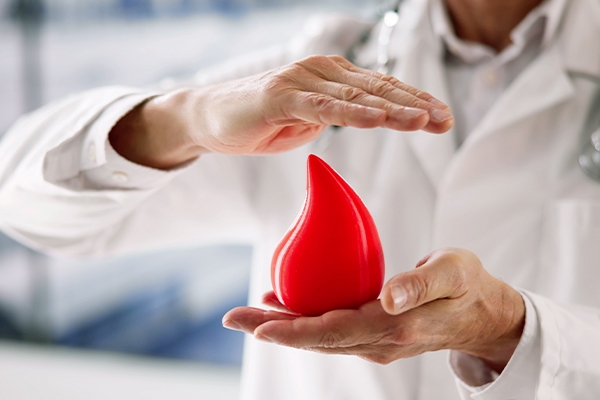Living with Hemophilia: Challenges and Ways to Improve Your Quality of Life

Hemophilia is more than just a blood clotting issue—it is a lifelong condition that has medical, mental, and social consequences for people affected. Every day, those living with hemophilia face new problems, ranging from complex treatments to limitations in daily activities. However, with proper care and a focused lifestyle, people with hemophilia can still live healthy and productive lives.
Understanding hemophilia

Hemophilia is an inherited blood disorder that causes the blood to have difficulty clotting properly due to a lack of clotting factors. In hemophilia A, the body lacks Factor VIII, while in hemophilia B, the body lacks Factor IX.
Read more: Hemophilia: When Blood Fails to Clot
This condition is most commonly seen in men, while women can be carriers of the gene and sometimes show symptoms of bleeding.
Common symptoms of hemophilia include:
- Easy bruising.
- Spontaneous bleeding without any apparent cause, especially in joints, muscles, and soft tissues.
- Excessive bleeding after injury or surgery.
- The majority of hemophilia cases are male. However, females can carry the gene that causes it.
Challenges of living with hemophilia
Receiving a diagnosis of hemophilia can be a confusing and emotional experience. Feelings of anxiety, anger, and even frustration are common. However, hemophilia impacts physical conditions, mental health, social life, and overall well-being.
Sufferers encounter problems that are not always obvious from the outside. After going through the emotional period, they still face many challenges in their daily life. Two of the most prevalent challenges are maintaining adherence to treatment and adjusting to limitations in carrying out daily activities.
1. Treatment compliance
Hemophilia treatment, especially those requiring regular intravenous infusions, can be challenging. Difficulty finding a vein, pain, risk of infection, and the time needed for therapy often make it difficult for sufferers to adhere to the treatment plan.
2. Daily activities
Hemophilia can disrupt routines, both at school, work, and home life. Children may have to miss school frequently. Meanwhile, adults can experience mobility impairments and pain due to bleeding, which impacts productivity and quality of life. Pain can even interfere with work or home life.
Tips to improve the quality of life

Regardless of the severity—mild, moderate, or severe—proper self-care can help hemophiliacs live better lives. Here are some practical steps you can take:
1. Prepare an emergency kit
Have an emergency kit to handle bleeding. This can provide a sense of security, especially outside the home.
2. Learn hemophilia first aid
Understanding how to identify and treat different types of bleeding is critical. Learn how to administer clotting factors at home and treat wounds that differ from regular first aid.
3. Exercise regularly
Safe, targeted physical activity helps strengthen muscles and joints and reduces the risk of bleeding. Choose low-risk activities such as swimming, yoga, cycling, dancing, or Pilates, and use protective clothing as needed.
4. Maintain a healthy diet
A well-balanced diet is essential in managing hemophilia. Eat foods high in iron, such as lean meats, green vegetables, and nuts, and combine them with vitamin C for optimal iron absorption. Avoid foods high in sugar, saturated fat, and excess salt.
Combining these foods with good sources of vitamin C, such as oranges and other citrus fruits, can help your body absorb iron better. Iron, vitamin C, vitamin B12, vitamin B6, and folate all play a role in the production of red blood cells, which helps maintain normal blood volume.
Vitamin E is also crucial for this process, but it can increase the risk of bleeding in high doses. Therefore, people with hemophilia should be careful when considering taking supplements that contain vitamin E and other substances that can increase the risk of bleeding.
5. Manage stress
Stress can trigger or worsen symptoms. Relaxation techniques, enjoyable activities, and social support can help maintain mental and physical health.
Managing stress improves general health, such as
- lowering the risk of heart disease and reducing the frequency of bleeding;
- relieving symptoms, such as muscle tension, headaches, and insomnia;
- strengthening the immune system.
6. Dental health care
Dental care is essential, but it must be done carefully. Visit your dentist regularly and tell him about your hemophilia so that he can provide safe treatment.
- In addition, take care of your teeth regularly.
- Brush your teeth twice a day with a medium-bristle toothbrush.
- Floss between the teeth.
- Swish with an antibacterial mouthwash.
- Limit your intake of sugary and acidic foods and drinks.
- Visit your dentist at least twice a year.
- While you won’t be able to prevent all bleeding, regular dental care is one of the best ways to minimize it when it comes to dental hygiene.
The importance of knowledge and support
The severity of hemophilia will determine the frequency of bleeding. People with mild hemophilia may only experience problems during major injuries or surgery, while people with severe hemophilia may experience spontaneous bleeding more frequently.
With good understanding, proper care routines, and support from those around you, living with hemophilia can be lived with an optimal quality of life.
Know your condition, take preventive steps, and do not hesitate to seek professional help. Join a community or support group to share your experiences, learn from others, and live a healthier and more meaningful life with hemophilia.



